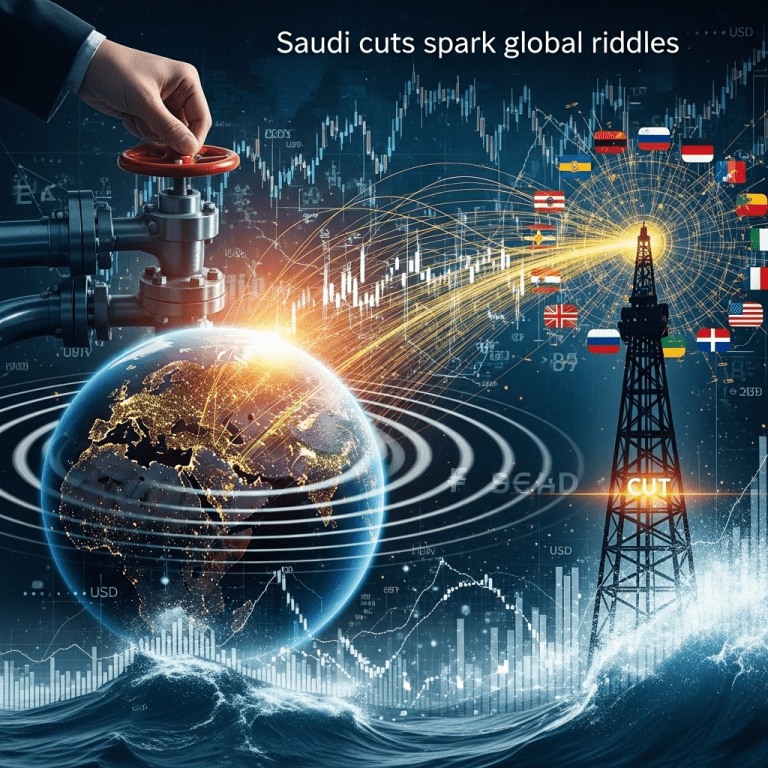The phrase “Saudi cuts spark global ripples” has become a centerpiece in financial news cycles worldwide as we move deeper into 2025. Recent decisions by Saudi Arabia to reduce oil production have triggered significant reactions across global markets, impacting not only energy prices but also investments, inflation trends, and geopolitical relations. In this article, we’ll unpack the far-reaching implications of these production cuts, guiding investors and business leaders on how to respond in a rapidly shifting economic environment.
Why Saudi Cuts Spark Global Ripples in 2025
Saudi Arabia, the world’s largest oil exporter, holds immense influence over international energy prices and, by extension, the broader financial markets. When Saudi cuts spark global ripples, the phenomenon is not limited to oil traders—it touches sectors from transportation to manufacturing, and even consumer goods. The 2025 round of production curbs, announced amid fluctuating global demand and geopolitical tension, has amplified these effects. Experts highlight how even minor output adjustments by the Kingdom reverberate through market sentiment and investment flows.
Immediate Impact: Oil Prices and Market Reactions
Oil Markets and the Price Shock
Upon Saudi Arabia’s announcement of tighter oil supply, oil prices spiked more than 10% within days. Such rapid escalation sent stock markets in energy-importing countries into a flurry, prompting analysts to raise their inflation forecasts. As crude benchmarks climbed, transportation and logistics firms braced for higher operating costs, while energy companies’ valuations surged. The volatility underscored the interconnectedness between Saudi policy moves and global financial stability. For a detailed breakdown of sector-specific impacts, visit our financial analysis portal.
Currencies and Capital Flows
The strength of the U.S. dollar, euro, and other major currencies was also impacted. Oil-importing economies experienced depreciation pressures, while exporters saw temporary boosts. Global investors shifted their portfolios, favoring energy equities and commodities over tech and consumer-focused assets. This rebalancing reinforced the importance of monitoring Middle Eastern decisions for macroeconomic forecasting.
Broader Economic and Strategic Consequences
Inflation and Global Growth Trajectories
As energy prices soared due to the Saudi cuts, global inflationary pressures re-emerged. Central banks faced renewed challenges in taming price increases, some even pausing planned rate cuts. Major economies like the U.S., Germany, and China revised their growth projections downward, citing higher energy costs and reduced consumer spending. The phrase “Saudi cuts spark global ripples” became synonymous with economic recalibration, prompting businesses to revisit supply chain strategies.
Geopolitical Relations Intensify
The implications of the cuts extended into international diplomacy. As Western countries urged Saudi Arabia to reconsider, OPEC+ stayed largely united, emphasizing the need to stabilize markets. Resource-dependent countries in Asia and Africa launched bilateral dialogues with Gulf producers, seeking more reliable supply agreements. In 2025, Saudi influence over both commodity prices and global politics has only strengthened, as seen in ongoing negotiations in multilateral forums.
Investment Strategies Amid Uncertainty
Energy Sector Opportunities
With Saudi cuts sparking global ripples, investors re-evaluated their allocations. Energy sector stocks gained appeal, especially among companies operating in upstream drilling or alternative fuels. Firms specializing in renewables also benefited, as energy security concerns fueled policy incentives for sustainable infrastructure. Learn how to identify the most promising energy and sustainability investments on our investment insight hub.
Diversification and Risk Management
For portfolios exposed to regions most affected by oil price swings, diversification became a priority. Investors hedged through energy ETFs, commodity-linked instruments, and inflation-protected securities. Financial advisors recommended a balanced approach, blending traditional defensive assets like gold with innovative climate-forward holdings to weather volatility driven by Saudi production strategies.
Navigating Continued Uncertainty in the 2025 Global Market
The reality that Saudi cuts spark global ripples is not new—but in 2025, the magnitude of these effects has grown. Policymakers, investors, and business leaders must remain agile, tracking developments not only within OPEC but also in renewables, geopolitics, and regulatory frameworks. By adopting dynamic risk management techniques and staying informed about production trends, stakeholders can better anticipate and respond to financial shocks. For the latest analysis and actionable advice, access our expert guidance center.
Conclusion: Staying Ahead as Saudi Cuts Spark Global Ripples
Saudi Arabia’s oil production policies will continue to shape the global financial environment well into the future. As Saudi cuts spark global ripples, prudent decision-making requires vigilance, flexibility, and a deep understanding of interconnected economic forces. By leveraging expertise, staying proactive, and utilizing diverse financial tools, investors and organizations can position themselves to thrive amid ongoing market turbulence.









